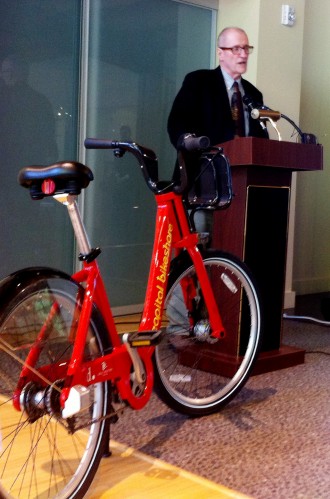
A common fear I hear when people talk about the launch of Puget Sound Bike Share next year is that the system will be dangerous without safer bike infrastructure downtown.
Even with the city working to build more than two miles of protected bike lanes downtown by the end of 2015, the lanes won’t be ready for more than a year after the proposed launch of a bike share system there. Won’t this lead to people with very little city cycling experience getting hurt?
Evidence suggests: No.
Many cities around the world with inferior bike infrastructure and more aggressive driving cultures have launched bike share systems that have proven to be extremely safe. From Dublin to London to Minneapolis, bike share systems have proven to be an order of magnitude safer than people using their own bicycles. In fact, though it’s hard to measure, bike share might even be the safest form of urban transportation.
Bike share is so safe that Barcelona believes their city’s system may actually save 12 lives every year due to the public health benefits the public bikes offer.
Now, even the mean (though getting nicer) streets of New York City have proven to be a safe place for a bike share system. In the first five months of operation, after more than 5,000,000 trips, zero people have died using CitiBike.
To many, the ingredients for New York City’s bike-share program suggested a sort of sadistic alchemy.
Start with notoriously unforgiving traffic. Add thousands of bicycles along the city’s most congested corridors. And see how perhaps the world’s least understanding drivers would cope with the new additions.
And one more thing: Many of the cyclists would be helmetless novices — or worse, tourists — careening into and out of lanes with the whimsy of a youngster pedaling through a suburb.
As of Monday, though, after more than five months and five million trips, none of the program’s riders have been killed on the bikes. About two dozen injuries, most of them minor, have been reported.
CitiBike users have effectively pedaled the distance around the globe more than 300 times, all on some of the most traffic-clogged streets in the nation with very few serious injuries. That’s amazing.
Of course, bike share systems in both Seattle and New York will be even more popular once the streets are updated to be more inviting to more people. But the work of making Seattle’s streets safer will never be done. As PSBS Director Holly Houser said recently to Cascade:
“If we waited for our bicycling infrastructure to be there, we may never launch because it could always be better. We are putting 500 more bikes on the road, and we are hoping it will get people on bikes who would usually be behind the wheel,” said Holly, adding that she hopes the new riders will grow Seattle’s bicycling momentum.
And that’s the point. The more people cycling — no matter their level of experience or whether they are wearing a helmet or even whether there are protected bike lanes on the ground — the safer cycling becomes for everyone. That 500 extra bikes on the road not only means at least some reduction in car traffic, but it also means 500 more people cycling on our streets, helping people who drive get used to operating safely near people on bikes.
This “safety in numbers” phenomenon has been seen in cities all other the world, including right here in Seattle.
Seattle is beyond ready for bike share.








Comments
One response to “After more than 5 million CitiBike trips, remarkably few injuries and zero deaths”
I think part of the New York success is that it is just so damn incredibly over-the-top popular — whenever I am down on 2nd Ave during rush hour, at least half the bikes are Citi Bikes. 2nd Ave has a protected lane below the 20s, almost all the way to the Manhattan Bridge, and is the favored route into Brooklyn, so you can sometime fantasize that you’re living in Portland when you’re riding it. Citi Bike has just enhanced that feeling. And it’s clear from a 30 second assessment that the Citi Bikes are ridden by seasoned cyclists and newbies and everyone in between (which is one of many reasons I just roll my eyes at the “OMG bikeshare newbiezombie apocalypse!!!” comments that are almost identical from city to city).
One quibble — and everyone who writes about bikeshare and nods to the newbie issue seems to overlook this: newbie cyclists don’t stay newbie for long. So it shouldn’t be a surprise: newbie tries out bikeshare, has a good experience, keeps riding bikeshare, gets skillz, becomes seasoned cyclist, becomes less prone to injury. etc. while simultaneously benefiting from the safety in numbers effect. Subsequent newbies then enjoy further enhanced safety in numbers while riding the steep but now even safer learning curve that is urban cycling.